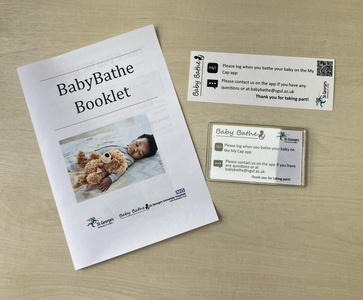Goldsmith, LP; Perkin, MR; Wahlich, C; Chandrasekaran, L; Cornelius, V; Boyle, RJ; Flohr, C; Roberts, A; Willis, K; Ussher, M
(2024)
Development of an intervention for reducing infant bathing frequency.
PLoS One, 19 (2).
e0298335.
ISSN 1932-6203
https://doi.org/10.1371/journal.pone.0298335
SGUL Authors: Ussher, Michael Henry Perkin, Michael Richard
|
PDF
Published Version
Available under License Creative Commons Attribution. Download (389kB) | Preview |
|
|
Microsoft Word (.docx) (S1 Table)
Supplemental Material
Available under License Creative Commons Attribution. Download (19kB) |
||
|
PDF (S1 File)
Supplemental Material
Available under License Creative Commons Attribution. Download (718kB) | Preview |
|
|
Microsoft Word (.docx) (S2 File)
Supplemental Material
Available under License Creative Commons Attribution. Download (114kB) |
||
|
PDF (S3 File)
Supplemental Material
Available under License Creative Commons Attribution. Download (888kB) | Preview |
|
|
PDF (S4 File)
Supplemental Material
Available under License Creative Commons Attribution. Download (759kB) | Preview |
|
![[img]](https://openaccess.sgul.ac.uk/116258/27.hassmallThumbnailVersion/pone.0298335.s006.jpeg)
|
Image (JPEG) (S1 Fig)
Supplemental Material
Available under License Creative Commons Attribution. Download (3MB) | Preview |
|
![[img]](https://openaccess.sgul.ac.uk/116258/32.hassmallThumbnailVersion/pone.0298335.s007.jpg)
|
Image (JPEG) (S2 Fig)
Supplemental Material
Available under License Creative Commons Attribution. Download (2MB) | Preview |
|
|
Microsoft Word (.docx)
Accepted Version
Available under License Creative Commons Attribution. Download (105kB) |
Abstract
BACKGROUND: Bathing babies less frequently and intensively in the first six months of life may prevent eczema, but this has not yet been definitively tested in a randomised controlled trial. Such a trial would require evidence-based support to help parents engage with a minimal bathing routine. The present study reports the development of this support. METHODS: We adopted a four-stage design process: (i) Pregnant women and their families (n = 31) were interviewed to ascertain key barriers and facilitators towards following the minimal bathing intervention. (ii) These barriers and facilitators were mapped to behaviour change techniques, focussing on the intervention types of education, persuasion and environmental restructuring, alongside appropriate modes of delivery, and prototype intervention materials were developed. (iii) We iteratively refined these materials in a workshop with multidisciplinary experts and Patient and Public Involvement and Engagement (PPIE) representatives (n = 13) and an (iv) intervention walkthrough with families (n = 5). The design process was informed by the Behaviour Change Wheel, Theoretical framework of acceptability and the Template for intervention description and replication. RESULTS: Social influences and motivational factors are likely to influence both uptake and adherence to the intervention. Anticipated emotional reward from participating in research for the benefit of others was indicated to be a strong facilitator for intervention uptake. Alternatives to bathing, having fun with the baby and the night-time routine, alongside family support, were notable facilitators suggested to aid adherence to the intervention. Barriers included hygiene concerns and anticipated negative social appraisal. Barriers and facilitators were mapped to thirty-six behaviour change techniques, focussing on the intervention types of education, persuasion and environmental restructuring, all of which were embedded into the package of support. The prototype intervention materials received positive feedback from the expert workshop and study walkthrough with families. The final package of support comprises printed and digital prompts and cues, a study booklet, video, and digital tool for self-monitoring. CONCLUSIONS: The intervention design process incorporated the 'real world' views and experiences of families, experts and PPIE representatives, alongside criteria for designing behavioural interventions. The effectiveness of the package of support will be tested in a feasibility trial and embedded process evaluation.
| Item Type: | Article | |||||||||
|---|---|---|---|---|---|---|---|---|---|---|
| Additional Information: | Copyright: © 2024 Goldsmith et al. This is an open access article distributed under the terms of the Creative Commons Attribution License (http://creativecommons.org/licenses/by/4.0/), which permits unrestricted use, distribution, and reproduction in any medium, provided the original author and source are credited. | |||||||||
| Keywords: | Pregnancy, Infant, Humans, Female, Educational Status, Behavior Therapy, Biological Transport, Cues, Eczema, Humans, Eczema, Cues, Behavior Therapy, Biological Transport, Pregnancy, Infant, Educational Status, Female, General Science & Technology | |||||||||
| SGUL Research Institute / Research Centre: | Academic Structure > Population Health Research Institute (INPH) | |||||||||
| Journal or Publication Title: | PLoS One | |||||||||
| ISSN: | 1932-6203 | |||||||||
| Language: | eng | |||||||||
| Dates: |
|
|||||||||
| Publisher License: | Creative Commons: Attribution 4.0 | |||||||||
| Projects: |
|
|||||||||
| PubMed ID: | 38421960 | |||||||||
 |
Go to PubMed abstract | |||||||||
| URI: | https://openaccess.sgul.ac.uk/id/eprint/116258 | |||||||||
| Publisher's version: | https://doi.org/10.1371/journal.pone.0298335 |
Statistics
Actions (login required)
 |
Edit Item |



